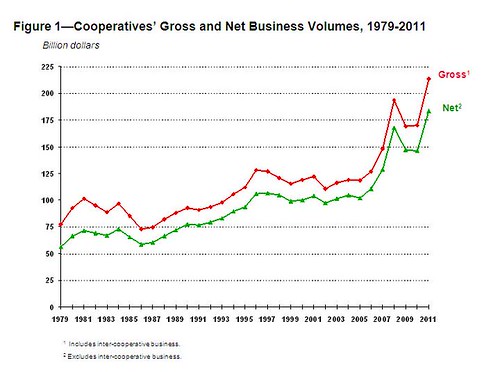
Since 1930, America has observed National Co-op month in October and what better way to celebrate the strength and vigor of cooperatives in the United States than to read a new USDA report, which notes that farmer, rancher and fishery cooperatives posted record sales and income in 2011, surpassing the previous record sales year of 2008 by $10 billion. Not only that, cooperatives bested the old income record by $500 million. Net income before taxes for all agricultural co-ops was a record $5.4 billion, eclipsing the previous high set in 2008. Net income was up more than 25 percent, or $1 billion, from 2010.
These new cooperative sales and income records for 2011 underscore the strength and productivity of the nation’s farmer- and rancher-owned cooperatives, and the vital role they play in the nation’s economy. Primarily because of mergers, the number of farm co-ops continued to decline, but memberships and asset values are up.
Also, co-op employment levels remained strong, with cooperatives employing 184,000 full-time, part-time and seasonal workers, up slightly from 2010.
The year also saw double-digit increases in prices for dairy products, cotton, livestock and grains and oilseeds. Farm production expenses also increased by double-digits in 2011, with feed, fertilizer and fuel prices leading the upward trend. The 2,285 surveyed cooperatives had sales of $213 billion, exceeding 2010 sales by more than $40 billion.
USDA’s annual list of the nation’s 100 largest agricultural cooperatives, also released today, shows that they also had record sales and income in 2011. The 100 largest ag co-ops reported revenue of $148 billion in 2011, an increase of almost 30 percent over 2010, when revenue totaled $113 billion. Net income for the 100 top co-ops was $3.17 billion, up from $2.35 billion in 2010. The previous top 100 co-op records were $130 billion for sales and $2.42 billion for income, both marks set in 2008. For more in-depth information about how the nation's agricultural cooperatives performed in 2011, see the September-October issue of USDA's "Rural Cooperatives" magazine here.
The figures above are important, but as important are the success stories that the cooperative model represents. For example, In Minnesota, The St. Peter Food Co-op needed to expand in order to meet increasing demand. Demand for the co-op's locally grown foods has steadily risen throughout the years. USDA, Rural Development guaranteed a $1.28 million Business and Industry loan guarantee to help the co-op purchase a vacant building in town and renovate it into a new store. In the Northeast, a group banded together in Vermont to overcome initial skepticism and open a food co-op to meet the grocery needs of the city of Burlington.
USDA and cooperatives have been and will continue to be strong partners in rural America. To learn more about how USDA supports cooperative ventures click here.To read the news release concerning today’s announcement, click here. To hear Under Secretary Tonsager make today’s announcement, click here.
